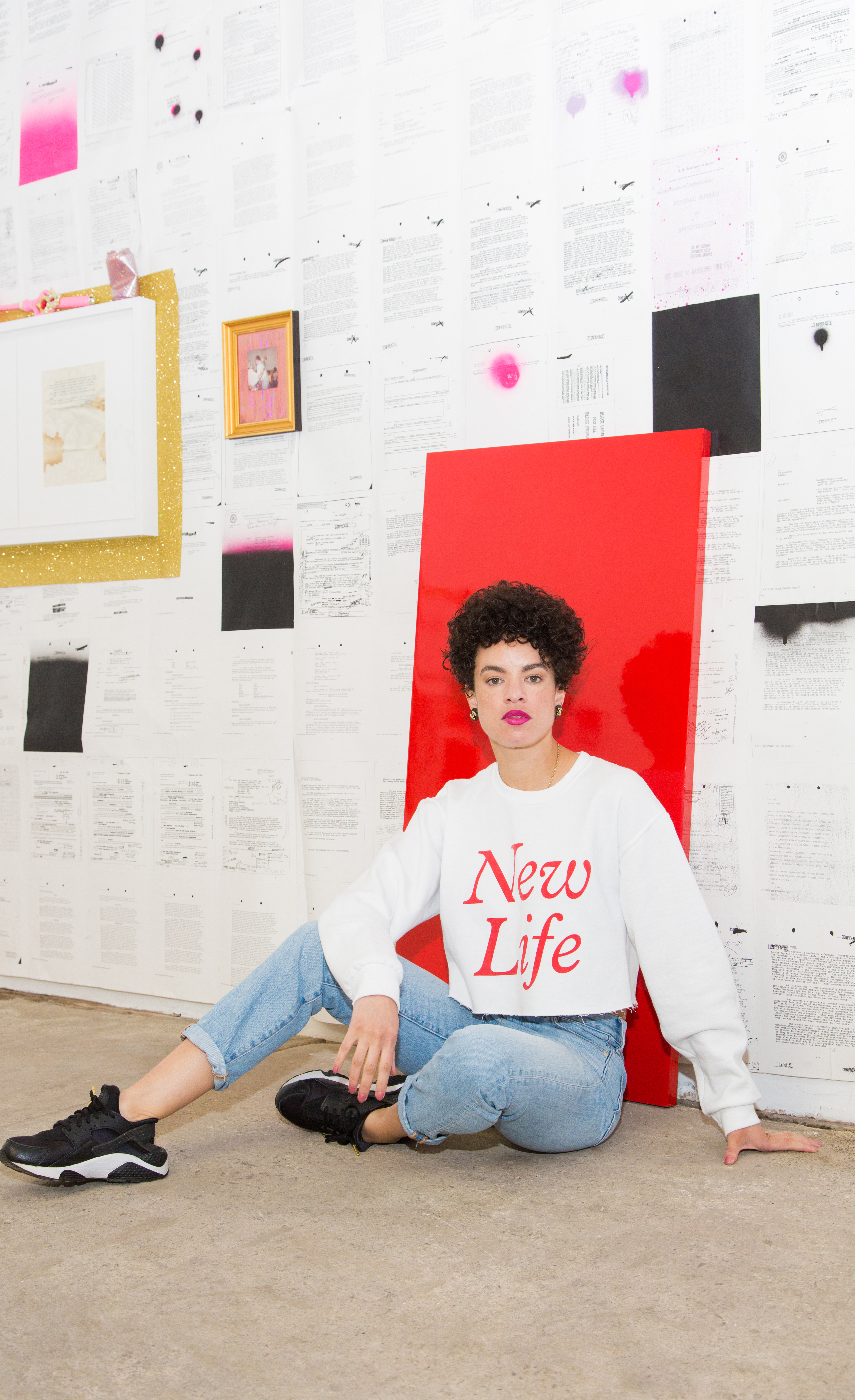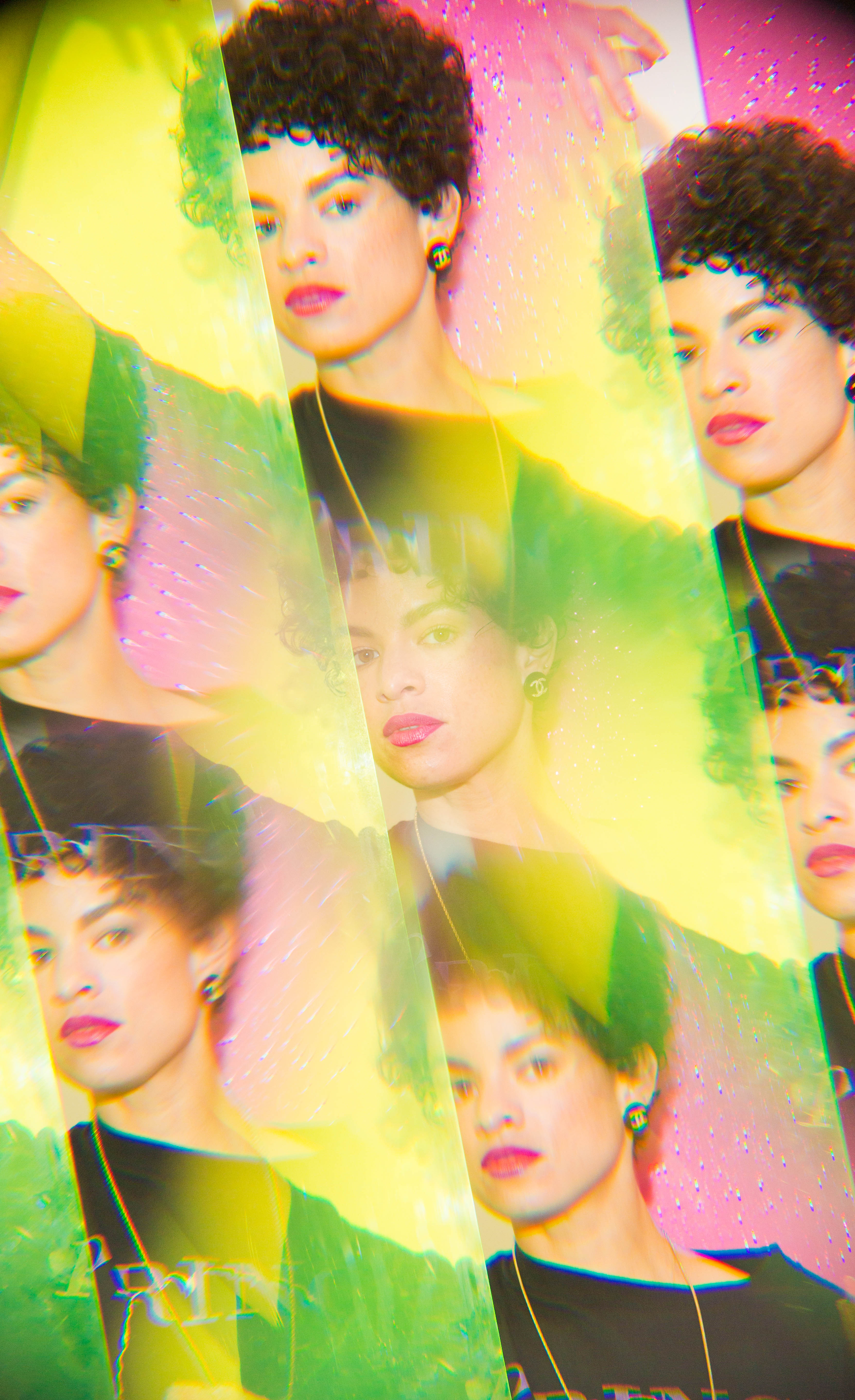
Take Bart (Bay Area Rapid Transit) right now to downtown San Francisco, and you’ll meet Sadie Barnette. She doesn’t live there (she was born and raised in Oakland, which she still calls home), nor is she popping up to walk you through the city. Barnette is present via two installations along the Mission Street corridor at 3rd Steet in San Francisco. Her installation at the Yerba Buena Center for the Arts glows pink from the glass atrium, illuminating a room with a lamp, a portrait and a glittery, vinyl-lettered “FROM HERE” on either side of a holographic couch.
Four hundred feet southwest is another Barnette: an immersive installation titled “PHONE HOME” at the Museum of the African Diaspora (MoAD). Electric pink appears again in the form of carpet and painted walls. The couch’s holographic material is found in this case on book covers with contents ranging from art history to speculative fiction. Bedazzled technology from the 20th century (boomboxes, computer towers and big ol’ speakers) are folded into the corners and underneath the counters of MoAD’s lobby, leading to a bright pink hallway with pink-tinged objects and framed images of black folks floating in atmospheres of glittered, multidimensional space.
I begin here, amongst Barnette’s art, in the venues closest to her town (“The Town”) to highlight Barnette as an architect of (black) homeplace and the value of imagining that place in a sea of pink and shimmer. This profile is a love letter to one of our Oakland heroes (I too am an Oakland kid, going back three generations) in the way Barnette’s work is a love letter to black possibility, liberation and restoration.

“I think about black people’s history in this country and how it’s always been about movement and making new homes where you are making connections—and how other people can feel at home even though they’re not from there because they’re from you,” Barnette explains over snacks on a recent Sunday morning in Berkeley. In these latest exhibitions in San Francisco—and in her solo exhibition last year at LA’s Charlie James Gallery, “BLACK SKY,” where Barnette transformed the entirety of the two-floor gallery into abstract domestic scenes with space- and time-bending kinesis using black and gray-scale wallpaper of the cosmos with enlarged family portraits and lightboxes on the top floor, a holographic couch, pink carpet and black American cultural articles in the basement—Barnette’s play with repetition and abstracted moments becomes something like a mantra on place.
Key to these latest works and Barnette’s concern with who and what is at stake when imagining black futures—and the present—is her work about her father, Rodney Barnette, who founded the Compton chapter of the Black Panther Party in 1968 and was subsequently surveilled and harassed by the federal government under COINTELPRO. These projects the artist began in 2016 amplify the 500-page FBI file compiled on the senior Barnette through wallpaper and enlarged portraits of the file’s pages. Here, the younger Barnette disaggregates the language used to violate and harass her father through bedazzling sections of text with pink spray paint, highlighting the brutality of the government’s efforts and the care that she, as his daughter, can restore—however small—to the materials.

Oakland shows up in the architecture, ephemera, snapshots and arrangements of Barnette’s pieces. Martin Luther King Jr. Boulevard, a “Free Huey” pin, a baby Barnette with her father and a white Toyota Hatchback are all Oakland artifacts that make cameos in her work. She takes up the city as a place which subsists with its past intact within its present moment. Oakland, like Compton (the past and present home of her father, aunts, uncles and cousins), materializes as a space vessel operating through and against time to remark upon what’s possible in the now. “I think about Sun Ra’s Space Is The Place and how it wasn’t about going to the future, but about how this other plane is available to you right now; you’ve just got to come to this community center in West Oakland,” explains Barnette. “It’s like there’s this parallel undercurrent of another dimension that we, as black people, sometimes get to access.” Pink, glitter and holograms are how Barnette allows black flourishment and refuge from the binds of gender propriety—Barnette calls pink “hyper-femme play”—and the historical and constant trauma of being black and alive. She works with the sanctity of light and uses the tension between delight and sorrow, inescapable from black subjecthood, to create visions for her audience.
Barnette and I grew up in the Bay together. We went to high school together. We grew in career together, and the breadth of our friendship blossomed into friends-family in the last few years. From her first solo exhibition in LA in 2016 to my first curatorial exhibition the following year, Barnette and I have been in continuous chatter. Conversations around her practice, art globally, blackness here and now and the state of the world pop up through texts, Bay Area and LA visits and DMs. These conversations point to but do not contain the whole of Sadie-ness. Rather, the point is the multiple read, the revisiting and the assurance that Barnette, steeped in these visions of blackness, wants us all to survive.
This story was originally published in LALA Magazine.




